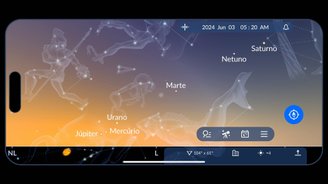In the early hours of Monday, June 3, an hour before sunrise, a relatively rare astronomical event can be seen in skies around the world: a planetary alignment, popularly known as a “planet parade.” In the Brazilian example, just before 5 a.m. the following can be seen: Mercury, Mars, Jupiter, Saturn, Neptune and Uranus.
Planetary alignments have been occurring in June since 2022, and this year will be no different. Although it is common to have several planets in the sky at the same time, when three or more planets align in an apparently straight line, this creates a planetary alignment. And if the event involves six or more planets, it is considered a major alignment.
In fact, the planets do not lie “back to back” as in a straight line in space. The show, although beautiful to see, is an optical illusion. So from the Earth’s perspective, it’s a coincidence, It is due to the position and inclination of the planets in their orbits at a particular time.
What will the planetary alignment be like on June 3?
Saturn (magnitude 1.1), which has a yellowish appearance, will be the first planet to appear late Sunday night (2) and will be visible to the naked eye in the constellation Aquarius. Neptune (mag. 7.9) will soon appear in the constellation Pisces, but because its size is larger (meaning less brightness in astronomy), it will only be visible with high-powered binoculars.
Later, Mars (mag 1.0), also in Pisces and with its traditional reddish color, will appear. At lower luminosity, the planet is brighter and can be observed with the naked eye.
(3) In the early hours of Monday, three remaining planets in the constellation Taurus will appear on the eastern horizon: Uranus (mag 5.8), Jupiter (mag -2.0) and Mercury (mag -1.4).
Uranus will only be visible through binoculars; Negative magnitude Jupiter will be bright enough to be seen with the naked eye; but Mercury will depend on luck: Although it has a negative magnitude, this is because the planet is very close to the Sun, which reduces its brightness.
How can I observe planetary alignment?

As with all celestial events, It is recommended that you find a place with clear skies and away from trees and tall buildings. It is also important that the area is partially free from light pollution caused by big cities.
Rural areas or remote locations may be good options. Then hope there are no clouds or rain at that time.
Although binoculars with 7x to 10x magnification are sufficient to observe Mercury, Neptune and Uranus, It is useful to have the astronomy application installed on your mobile phone, Like Sky Tonight. With it, you will be able to point your device at the sky, identify stars, planets and constellations, and check the current time.
Did you like the content? Stay up to date on more topics like this at TecMundo and take the opportunity to explore the 126 exotic exoplanets revealed in NASA’s new catalogue. To the next one!
Source: Tec Mundo
I’m Blaine Morgan, an experienced journalist and writer with over 8 years of experience in the tech industry. My expertise lies in writing about technology news and trends, covering everything from cutting-edge gadgets to emerging software developments. I’ve written for several leading publications including Gadget Onus where I am an author.












